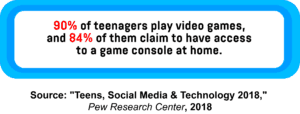- Games can improve learning experiences
- Schools demonstrate the educational value of game design elements
- Learning how to navigate the internet
- Using gaming to promote STEM learning
- The e-sports industry is changing education
- E-sports could help create a better connected community
- Preparing students for the future of work
- Gaming engages and educates students
The future of work is likely to be vastly different than what people experience today. Automated systems are set to take over repetitive tasks, enabling humans to spend more time on complicated issues. The changing labour market also means that current education systems need to evolve beyond teaching students only traditional skills like reading, writing, and math. Instead, teachers need to find a way to help children develop 21st-century skills, such as critical thinking, collaboration, and empathy, which will help them to excel in an increasingly complex world. And one way to help students improve is to use video games and game design elements.
Games can improve learning experiences
According to a 2018 Pew Research Center survey, 90 per cent of teens play video games, indulging in experiences rooted in gamification principles, such as rewards, frequent feedback, and attractive narratives. And while certain teachers criticise this habit, others have taken a different approach. Some US schools, for instance, have introduced the online shooter game Fortnite as an extracurricular activity to develop students’ soft skills like socialisation and collaboration. Games like Civilization, which simulate the administration of a state, are known for improving users’ managerial skills. And like no other form of popular culture, gaming is actually improving “the decision-making apparatus of the brain”, says Alessio Ceccherelli, a researcher at the University of Rome Tor Vergata.

Many studies have shown that games can have positive effects on learning. Highly competitive games, for instance, help players develop collaboration skills as they work with others to win. Multiplayer role-playing games are beneficial, too, as children can hone their problem-solving techniques to overcome particular quests. And requiring players to create something during or after gameplay can improve their critical thinking skills. Of course, experts aren’t suggesting that staring at a screen for an entire day equips children with relevant skills. Instead, as several schools have already demonstrated, a combination of gaming and pedagogical methods can yield great benefits.
Schools demonstrate the educational value of game design elements
Quest to Learn is a New York-based public school with an educational philosophy that focuses on adding game design elements to almost anything children do. For example, learning objectives are called quests, while a group discussion technique known as Socratic Seminars has been reframed as Socratic Smackdowns, with students earning points for well-structured arguments. Final exams are designed as multi-level missions with the ‘final boss’ waiting at the end. And students play games only 10 per cent of the time, spending the rest of the day on other activities. Research shows that Quest to Learn 8–10-graders develop critical thinking, problem-solving, and writing skills twice as fast as college students.
Dag Hammarskjold Middle School is another American school that relies on gaming systems to improve learning outcomes. It uses an educational game called Classcraft that enables students to compete in challenges and collect experience points, which can be spent on perks. And players don’t fight against each other, but rather use the collected points to pass to the next level or exchange it for listening to music in class. They can also compete against other classrooms, and teachers can take away points from students who behave badly.
Learning how to navigate the internet
Knowing how to navigate the online world is another critical skill that children need to learn. Fortunately, Google developed an adventurous online game named Interland, which teaches them how to use the internet safely. The game revolves around four islands called Mindful Mountain, Tower of Treasure, Kind Kingdom, and Reality River. Each level focuses on different topics, such as how to create good passwords, treat others kindly, spot fake news, and be careful about sharing private details online. Also, the virtual reality (VR) game Project Axon shows gamers how fake information spreads, while the US Federal Trade Commission created a game called Admongo, which helps children to spot advertising and sponsored content online.
Researchers at the University of California, Berkeley, have also developed tech-based solutions for educational challenges. One of those is the Virtual Tutor, an AI-based voice assistant that can be embedded into games to interact with users. And one of the games that uses this feature is GoWings Safari, launched by the tech firm Blue Goji. It’s a safari-themed visual experience, during which the Virtual Tutor talks with the player and provides details about animals that appear on the screen.
Using gaming to promote STEM learning
Children’s interest in games can be used in other ways, too, such as to improve STEM learning. Geckoman, for instance, is a game that teaches high school students the basics of nanotechnology. Players navigate different worlds to recover pieces of a scientist’s notebook, learning more about physical forces and other useful concepts along the way. And interactive educational programs such as Code Ninjas motivate students to learn coding by developing games or apps that they would want to use.
Older students can also benefit from game-based learning. A team from the Institute for Molecular Medicine and Infectious Disease at Drexel University in the US developed an educational game called CD4 Hunter. Students roleplay as the human immunodeficiency virus type 1 (HIV-1) and have to navigate through the bloodstream, get past immune defences, and infect cells. The team, led by an assistant professor, Sandra Urdaneta-Hartmann, is satisfied with the way this game improved student learning experiences. And the plan is to develop even more games that will focus on parasites that cause malaria, bacteria, and fungi, as well as various other microbiology topics.
The e-sports industry is changing education
In the past few years, gaming has transformed from a pastime into a sports activity, engaging millions around the world. Due to its popularity, e-sports, or competitive gaming, has grown into a huge industry, bringing revenue of $1.1 billion in 2019, which is expected to reach as much as $3.2 billion by 2022. E-sports, however, extends far beyond the entertainment industry, and there’s a growing number of educators who support the idea that the inclusion of e-sports as a regular extracurricular activity could, in fact, improve STEM education in high schools and help students develop new skills.

Given the number of teens playing video games, 97 per cent of teenage boys and 83 per cent of girls, according to Pew Research Center, e-sports as an extracurricular activity in schools could “reach students who often are otherwise disengaged from the school community” and “transport these kids from the solitary world of digital gaming into the common space of the school computer lab or library commons”.
E-sports could help create a better connected community
Some believe that e-sports could be a new way for high schools and higher education institutions to revitalise their STEM programmes, closing the existing racial- and gender-based gaps in STEM education. In fact, according to the American Council on Education, African American and Hispanic students were reported to be “the least likely to enroll in and complete their degree programs, accounting for just 12 and 17 percent, respectively, of all STEM graduates”. And UNESCO reports that even though there’s a growing number of female STEM graduates, there’s still a noticeable gender gap in STEM fields. It appears, though, that e-sports could be used “as a platform to build and grow interest in STEM”, the Connected Learning Alliance claims.
In 2018, a team of researchers at the University of California, Irvine (UCI), managed to identify practices that, if implemented, could help institutions ensure that underrepresented students connect through e-sports and develop a sense of belonging and acceptance while exchanging knowledge and experience. For example, themed housing could be the perfect setting for women and men to encourage each other to discuss STEM subjects through a mutual appreciation of gaming. As the UCI research team explains, “We believe that esports has the opportunity to create a competitive environment that transcends geography, race, ethnicity, gender identity, sexual orientation, language and religion.”
Preparing students for the future of work
However, game-based learning doesn’t have to involve impressive graphics. It can be as simple as finding ways to challenge students to learn important concepts in a rewarding way. And the goal isn’t merely to teach facts. Microsoft and McKinsey, for instance, claim that social-emotional skills such as decision-making, personal responsibility, and social awareness will be critical for 30 to 40 per cent of future jobs. And by 2030, predictable manual work is set to be in steep decline, while demand for creatives, managers, and tech professionals will keep growing. Preparing children for such a future requires educators that will “zero in on the elements that make us decidingly human”, and games can provide invaluable assistance in that regard.
Gaming engages and educates students
Throughout history, teachers have been trying to make learning both effective and fun. And while studying algebra and biology can rarely be as exciting as playing Fortnite, educational games can lead to impressive outcomes. They can help prepare young people for the challenges of the tech-dominated world, teach them how to behave online, and provide a range of social skills that will be in high demand. Creating efficient game-based learning experiences takes time and effort, but using gaming passions to foster learning is probably the best way for educators to engage students and prepare them for the challenges of the future.




